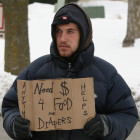
Fractured Leg, Fractured Family: A Misdiagnosis Leads to Allegations of Child Abuse
|
When Anthony Richards, Jr., was born on an early Sunday morning in June, the only complications involved his family getting the cameras in focus to capture his arrival into the world. He was a healthy baby and his parents, Queenyona Boyd and Anthony Richards, Sr., couldn’t have been happier. Yet, only four days later Anthony was put in foster care after doctors discovered an unexplained broken femur, his distraught parents the suspects of child abuse. A Protective Father's Discovery
After the hospital discharged Boyd and her baby boy, Richards took the two straight home later that Sunday. The following day, Boyd slipped out to pick up her prescriptions at a pharmacy only a short drive away.








